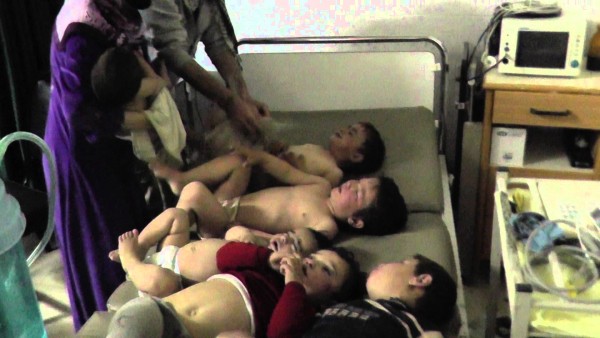Human Rights Watch has reinforced claims that the Assad regime attacked civilian areas with chemical weapons on several occasions last month: “Evidence strongly suggests that Syrian government helicopters dropped barrel bombs embedded with cylinders of chlorine gas on three towns in Northern Syria in mid-April 2014.”
See Revealing Assad Regime’s Latest Chemical Weapons Attacks
Regime Chemical Attack in Idlib Province with 100+ Casualties?
VDC Report on Regime’s Chemical Weapons Attack on Kafrzita
Chemical Warfare — Regime Uses Chlorine Gas on Kafrzita in Hama Province
Human Rights Watch interviews with 10 witnesses, including five medical personnel, video footage of the attacks, and photographs of the remnants strongly suggest that government forces dropped barrel bombs containing embedded chlorine gas cylinders in attacks from April 11 to 21 on three towns in northwestern Syria. Witnesses told Human Rights Watch they saw a helicopter dropping a barrel bomb or heard a helicopter immediately prior to an explosion, followed immediately by a peculiar odor. The witnesses consistently described the clinical signs and symptoms of exposure to a choking agent (also known as a lung or pulmonary agent) by victims.
According to doctors who treated the victims and subsequently spoke to Human Rights Watch, these attacks killed at least 11 people and resulted in symptoms consistent with exposure to chlorine in nearly 500 other people.
Treatment of victims in Kafrzita:
The attacks documented by Human Rights Watch are:
*On Keferzita, a town northwest of the city of Hama in the Hama governorate, on April 11 and 18 that killed 2 people and affected an estimated 200 people, 5 of them seriously, according to a local doctor;
*On al-Teman’a, a small town north of the city of Hama in Idlib governorate on April 13 and 18 that killed at least 6 and affected approximately 150 people, according to a member of the medical team in the field hospital and a second witness; and
*On Telmans, a town southeast of the city of Idlib in Idlib governorate, on April 21 that killed 3 people and affected an estimated 133, according to a volunteer at the local field hospital.
Telmans is 3 kilometers east of the government-controlled military base at Wadi al-Deif and 11 kilometers from al-Hamid, areas that witnesses described as the nearest front lines. Al-Teman’a is 7 kilometers from Khan Sheikhoun, which witnesses said is the nearest front line; Keferzita is 10 kilometers from Khan Sheikhoun. In an attack on Keferzita on April 11, a witness stated that fighters from an armed non-state armed group occupied a position 500 meters outside of town.
Video evidence and information published by local activists also suggest that barrel bombs with chlorine were used in Keferzita on April 12. Human Rights Watch was not able to corroborate these reports with witness accounts.
Seven of 10 people interviewed by Human Rights Watch reported smelling a distinct odor in the area targeted by the barrel bombs. They remarked that this odor was familiar and similar to that of common household cleaners. The witnesses are likely referring to bleach-containing cleaners, which comprise several chlorine-containing compounds, mainly hypochlorous acid. When chlorine gas dissolves in water, including water vapor in the air and water in the mucous membranes in the nose, hypochlorous acid is formed in large amounts. The report of an odor similar to that of household cleaners is consistent with the presence of chlorine gas.
Several interviewees reported that the odor lingered for several hours. Although chlorine gas itself is not persistent, these accounts are consistent with the persistence in the environment of hypochlorite compounds formed from the chlorine gas when it mixes with vapor in the air and mucous membranes in the nose.
Half of the people interviewed by Human Rights Watch reported that the explosion of the barrel bombs produced “yellow smoke” or “dark yellowish smoke” in addition to the usual smoke from bomb explosions. A video shot on the western edge of Keferzita and uploaded to YouTube on April 11 shows the near vertical descent and detonation of an unidentified munition fully consistent with a barrel bomb dropped by helicopter. Several seconds after the explosion, a distinct yellow patch (see photo 4 below) forms at the base of a large cloud of dust and debris drifting to the east. Pure chlorine is a pale yellowish green in color. Such reports of an unusual “yellow smoke” at the attack site are consistent with the release of chlorine gas from the rupture of industrial compressed gas cylinders.
All the medical personnel interviewed reported seeing clinical signs and symptoms of exposure to chlorine immediately after the barrel bomb explosions. Mild exposure causes reddening and itchiness of the eyes and difficulty seeing. More severe exposure leads to breathing difficulties and complaints of shortness of breath. Even higher levels of exposure can lead to vomiting, severe respiratory distress, uncontrollable coughing, and even suffocation, as the chemical injuries inflicted by the hydrochloric and hypochlorous acids produced from the dissolution of chlorine in the pulmonary airways result in severe buildup of fluid in the lungs. Interviewees reported seeing victims suffering from all three levels of exposure….
Videos of barrel bomb remnants found after the attacks on Keferzita on April 11 and 18 and the attack on Telmans on April 21 show yellow cylinders or canisters together with remnants of barrel bombs. The canisters contain markings with the code “CL2” – the symbol for chlorine gas – and “NORINCO,” indicating that the cylinders were manufactured in China by the state-owned company NORINCO. Yellow is the standard industrial gas color code for chlorine.

